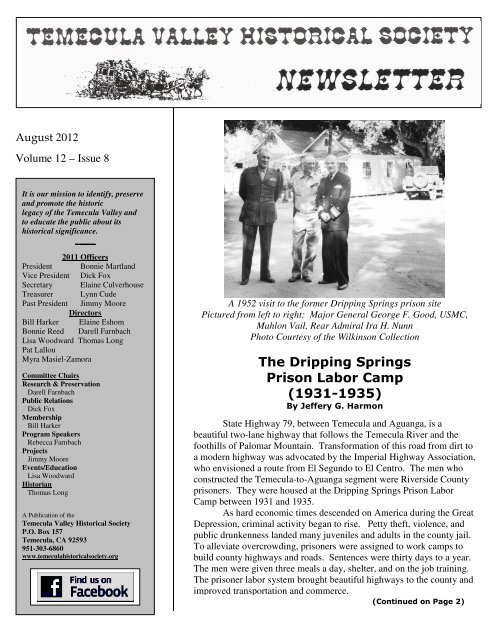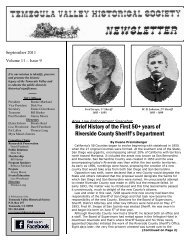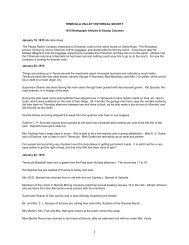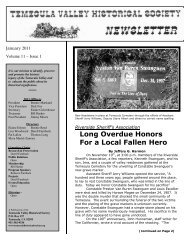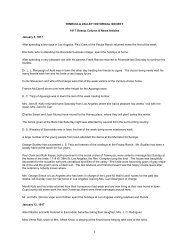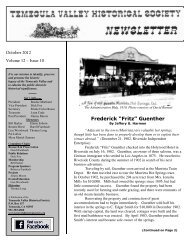The Dripping Springs Prison Labor Camp - Temecula Valley ...
The Dripping Springs Prison Labor Camp - Temecula Valley ...
The Dripping Springs Prison Labor Camp - Temecula Valley ...
You also want an ePaper? Increase the reach of your titles
YUMPU automatically turns print PDFs into web optimized ePapers that Google loves.
August 2012Volume 12 – Issue 8It is our mission to identify, preserveand promote the historiclegacy of the <strong>Temecula</strong> <strong>Valley</strong> andto educate the public about itshistorical significance._____2011 OfficersPresident Bonnie MartlandVice President Dick FoxSecretary Elaine CulverhouseTreasurer Lynn CudePast President Jimmy MooreDirectorsBill Harker Elaine EshomBonnie Reed Darell FarnbachLisa Woodward Thomas LongPat LallouMyra Masiel-ZamoraCommittee ChairsResearch & PreservationDarell FarnbachPublic RelationsDick FoxMembershipBill HarkerProgram SpeakersRebecca FarnbachProjectsJimmy MooreEvents/EducationLisa WoodwardHistorianThomas LongA Publication of the<strong>Temecula</strong> <strong>Valley</strong> Historical SocietyP.O. Box 157<strong>Temecula</strong>, CA 92593951-303-6860www.temeculahistoricalsociety.orgA 1952 visit to the former <strong>Dripping</strong> <strong>Springs</strong> prison sitePictured from left to right: Major General George F. Good, USMC,Mahlon Vail, Rear Admiral Ira H. NunnPhoto Courtesy of the Wilkinson Collection<strong>The</strong> <strong>Dripping</strong> <strong>Springs</strong><strong>Prison</strong> <strong>Labor</strong> <strong>Camp</strong>(1931-1935)By Jeffery G. HarmonState Highway 79, between <strong>Temecula</strong> and Aguanga, is abeautiful two-lane highway that follows the <strong>Temecula</strong> River and thefoothills of Palomar Mountain. Transformation of this road from dirt toa modern highway was advocated by the Imperial Highway Association,who envisioned a route from El Segundo to El Centro. <strong>The</strong> men whoconstructed the <strong>Temecula</strong>-to-Aguanga segment were Riverside Countyprisoners. <strong>The</strong>y were housed at the <strong>Dripping</strong> <strong>Springs</strong> <strong>Prison</strong> <strong>Labor</strong><strong>Camp</strong> between 1931 and 1935.As hard economic times descended on America during the GreatDepression, criminal activity began to rise. Petty theft, violence, andpublic drunkenness landed many juveniles and adults in the county jail.To alleviate overcrowding, prisoners were assigned to work camps tobuild county highways and roads. Sentences were thirty days to a year.<strong>The</strong> men were given three meals a day, shelter, and on the job training.<strong>The</strong> prisoner labor system brought beautiful highways to the county andimproved transportation and commerce.(Continued on Page 2)
CalendarOf EventsThursday, August 9 – 7 p.m.<strong>Temecula</strong> <strong>Valley</strong> MuseumGallery Talk: Kevin NoblePresents “<strong>The</strong> Old West”Monday, August 13 – 6:30 p.m.<strong>Temecula</strong> <strong>Valley</strong> GenealogicalSociety: Wayne Rogers presents“War of 1812, 200 th Anniversary”At the <strong>Temecula</strong> Civic CenterTuesday, August 14 – 5:30p.m.Author James ThomasPresents, Lewis & Clark and<strong>The</strong> Corp of DiscoveryAt the Elks LodgeFor more information contact:James ThomasEmail:Jimthomas41@gmail.comPhone: 760-742-1464Monday, August 27 – 6 p.m.TVHS monthly meeting at Little<strong>Temecula</strong> History CenterGordon Johnson presents:“Old Songs from Pala”A Pala Tribal Member, authorAnd former newspaper columnistHis books will be available forPurchase following the programSee President’s Message forMore information.Monday, September 24– 6 p.m.TVHS monthly meeting at Little<strong>Temecula</strong> History CenterReena Deutsch, PhD, presents:“San Diego & Arizona Railway:<strong>The</strong> Impossible Railroad.”<strong>Temecula</strong> <strong>Valley</strong> MuseumExhibitionJune 30 ~ September 16, 2012“<strong>The</strong> Old West”Take a look back at daily wear in<strong>The</strong> Old West during the late1800’s.TVHS Newsletter, Volume 12 – Issue 8Published by <strong>Temecula</strong> Historical SocietyPage 2 – August 2012(Continued on Page 2)<strong>Camp</strong> (Continued from Page 1)Elwood C. Wickerd, foreman for the Elsinore road district, waspromoted to superintendent of the Keen <strong>Camp</strong> <strong>Prison</strong>er <strong>Labor</strong> <strong>Camp</strong> inJune 1927. <strong>The</strong> camp was located near Mountain Center, at presentday McCall Memorial Park. At that time, the camp was working on theHemet-Idyllwild Road, which would be followed by the Pines-to-PalmsHighway. By 1931, the camp had completed its assignments in theSan Jacinto Mountains and was to be relocated to <strong>Dripping</strong> <strong>Springs</strong>.<strong>The</strong> Vail Ranch leased 18 acres to the county for the campsite.In May 1931, twenty-five prisoners, housed in temporary quarters,began constructing the new prison labor camp. Two guards wereassigned to oversee the project.<strong>Prison</strong>ers built “a 4 ½ mile pole-line for electricity and a 5 ½mile line for telephone service; built a complete water system andinstalled a pumping-plant and a storage tank; constructed a sewagesystem; and lay gas pipes from portable tanks to the variousbuildings.” (January 1, 1932, Riverside Daily Press)One day, when Superintendent Wickerd visited the constructionsite, he saw a sign the prisoners had installed at the entrance.“A $100,000 hotel and health resort now under constructionhere. For reservations apply to (Judges) G. R. Freeman and O.K.Morton.” (June 2, 1931, Riverside Daily Press)Inmates were transferred to <strong>Dripping</strong> <strong>Springs</strong> in October.Juveniles were kept at Keen <strong>Camp</strong> to do highway maintenance. <strong>The</strong>new Riverside County Jail had 81 inmates and the prison camps had100. <strong>Dripping</strong> <strong>Springs</strong> was assigned a three year building project. <strong>The</strong>camp would build thirty miles of 80-foot wide highway from <strong>Temecula</strong>to Aguanga. Superintendent Elwood C. Wickerd was confident that hismen could get the job done.<strong>The</strong> workday began at 6:30 each morning and ended in theevening in time to reach the camp by 6:00 p.m. Good behavior wasrewarded with ten days off each month and it helped shorten aninmate’s term if his conduct in camp warranted it. <strong>The</strong>re were elevenguards, some with the road crew, a couple at the camp, some on nightduty and a few taking turns on the Sunday shift.During a tour of Riverside County, Mrs. Clara M. Pettus,inspector of jails for the State Department of Social Welfare noted,“[<strong>Prison</strong> <strong>Labor</strong>] does not take away jobs from citizens, because theroads which are being built by the prisoners would not be constructedat all if the counties had to let contracts for such jobs.” (April 19, 1932,Riverside Daily Press)During construction, in the spring of 1932, the road crewdiscovered a human skeleton 22 feet below the surface. Dr. Charles S.Bacon and several students from the Riverside Junior College’sgeology department visited and studied the site. <strong>The</strong>ir findings andconclusions were not reported in the papers.(Continued on Page 3)
100 Years AgoRiverside IndependentEnterpriseAugust 14, 1912Sugar Beets will be addedE. E. Barnett, who owns 1000acres of level valley land alongthe Santa Fe railway, about twomiles north of <strong>Temecula</strong>, is oneof the stockmen who is going toplant beets according to DeputySheriff D.G. Clayton. Barnetthas made money in the stockbusiness, and has given ranchesto each of his children, but heremarked yesterday that $50 anacre which he could get for hisbeets meant the end of the cattlebusiness for him. He and F. H.Hall with two other men havegone in together on aproposition to supply anAnaheim factory on a contract.<strong>The</strong> Fullerton cut-off of theSanta Fe makes it easy for thevalley product to reach a marketuntil factories are established onthe ground.Another promising feature inthe neighborhood is indicatedby the new well sunk by thesemen. At a depth of 540 feetwater was struck that flows 18inches over the top of the 12-inch casing. <strong>The</strong> casing has notbeen perforated. When, in afew days perforating machineswill be sent down, a muchstronger flow is expected,ample for all the ranches in theneighborhood. <strong>The</strong> water is tobe handled with an aircompressor, which will do awaywith the usual pumpingoperations.TVHS Newsletter, Volume 12 – Issue 8Published by <strong>Temecula</strong> Historical SocietyPage 3 – August 2012<strong>Camp</strong> (Continued from Page 2)In July 1932, $50,000 was cut from the county roadconstruction budget. All machinery operation came to a halt. Paidcounty road employees were laid off. Road construction continuedonly with picks and shovels. However, Wickerd and his guardsremained on the county payroll.Besides the <strong>Temecula</strong> to Aguanga road, the camp constructedother roads. In 1933, a small group of inmates realigned BundyCanyon Road in Wildomar. In 1935, the road crews finishedconstructing the Aguanga to Cahuilla Road. <strong>The</strong>re were plans for thecrew to build a road from Aguanga to Hemet along the St. John’sGrade, but the project was postponed.By 1935, the city of Banning began pressuring the county tomove the prison camp back to Mt. San Jacinto. Civic leaders wantedthe Banning to Idyllwild Road realigned and straightenedimmediately. <strong>The</strong> decision was made to transfer the inmates back toKeen <strong>Camp</strong>. <strong>Dripping</strong> <strong>Springs</strong> was abandoned in July 1935. Onehundred prisoners were transferred to the mountain camp.From 1928 to 1939, Superintendent Wickerd had 3,323inmates at the prison camps constructing Riverside County roads andhighways. <strong>The</strong>re were 56 escapes during that time and all but onewas captured. Escaped convicts knew that if they were caught, theywould be sent to San Quentin or Folsom state prisons.Today the camp’s legacy can be enjoyed by motorists whodrive along State Highway 79 between <strong>Temecula</strong> and Aguanga. VailLake Resort now occupies the former prison site. <strong>The</strong> highwayremains a testament to the men of the <strong>Dripping</strong> <strong>Springs</strong> <strong>Prison</strong> <strong>Labor</strong><strong>Camp</strong>, whose blood and sweat paved the way for the area’s futuregrowth and economic prosperity.Further Readings:For Tourism and a Good Night’s Sleep, J. Win Wilson, WilsonHowell, and the Beginnings of the Pines-to-Palms Highway by SteveLech (2012)From the Desert to the Sea: <strong>The</strong> Story of Imperial Highway by PhilBrigandi (<strong>The</strong> High Country Magazine Issue 67)69 Years AgoMay 21, 1943Riverside Daily PressWriter Seeks Bandit Cave near <strong>Temecula</strong>Mrs. Carrie F. Horne of Costa Mesa recently spent severaldays at the Palomar Hotel, <strong>Temecula</strong>. She is a historical writer andwas looking for a cave in which legend says bandits hid when holdingup the Butterfield Stage between 1858 and 1861.If pictures of the cave can be taken, Mrs. Horne expects topublish them in a series of articles on old California.
115 Years AgoPress and HorticulturistAugust 21, 1897<strong>The</strong> Sunset TelephoneCompany’s line to San Diegohas been completed and theburg of bay’n climate can nowtalk to the rest of the worldthrough the medium of the hellogirl. <strong>The</strong> opening of the linegives telephone connections toElsinore and <strong>Temecula</strong> inRiverside County and SanDiego, Escondido, NationalCity and <strong>Valley</strong> Center in SanDiego County.75 Years AgoAugust 19, 1937Riverside Daily PressOswald Brothers ConstructionCompany, which has had acamp established near LeeLake, while its truck werehauling sand and gravel for theimprovement work on theOrtega highway, is moving itscamp to a point below<strong>Temecula</strong> near Aguanga.From here it will haul materialsfor use on the <strong>Temecula</strong>highway.Letter from the Editor:Dear Readers:We need your help with ourupcoming story.November: <strong>The</strong> Sam HicksMonument ParkIf you have any memories ofthis park between 1968-1982we would love to hear fromyou! Please call or email usand together we can tell thehistory of this wonderful park!President’s Message by Bonnie MartlandWe have had, and have; some pretty interesting and colorfulcharacters who call the <strong>Temecula</strong> <strong>Valley</strong> home. If you are reading thenewsletter, you have most probably become familiar with a number of them.However, if you have not been attending our monthly speaker presentations,you have missed hearing about some even more truly intriguing people. Atour last general meeting Steve Williamson, of the <strong>Temecula</strong> <strong>Valley</strong> Museum,gave a presentation on one of the most colorful – and famous - of<strong>Temecula</strong>’s residents; Erle Stanley Gardner. Steve spoke of him almost asone would a long-time eccentric, ambitious, colorful and indefatigable friend.A lawyer, writer of Perry Mason and other mystery stories, photographer,archer, producer, founder of the Court of Last Resort, amateur explorer; andso on; he was a truly remarkable man.This month’s meeting will feature Gordon Johnson local writer, editorand humorist. Author of Rez Dogs Eat Beans, and Fast Cars and Fry Bread,Mr. Johnson is a Cahuilla/Cupeno Indian who lives on the Pala IndianReservation. A former columnist and feature writer for the Press Enterprise,he has recently earned his master’s degree in fine arts. I heard Mr. Johnsonspeak a few months ago and was enthralled by the artistry with which he useswords to paint a visual and auditory picture. Like Erle Stanley Gardner, he isa photographer, and a master story teller with a wry wit and wonderful senseof humor. He has clarity of insight and a style that as I read, or listen to, canmake me laugh and make me cry. Reservation life …family life…his familyhas ties to early <strong>Temecula</strong> and Murrieta and their local lore.Don’t miss Mr. Johnson’s presentation. I don’t think he would mindbeing described as a colorful local character…as long as I make clear I meanartistically and grammatically.25 Years Ago This MonthAugust 26, 1987, Rancho NewsVolunteers are life-blood of MuseumApproximately 35 local residents volunteer at the (Old Town <strong>Temecula</strong>)museum, many from the Rancho-<strong>Temecula</strong> Women’s Club and according toRay Meyer, president of the museum board, they are crucial to the museumprograms.“We couldn’t open the doors without them.” Meyer said. “We rely totallyon the docents. We wouldn’t be able to afford to pay anybody for even fivehours a week.”Tony Tobin, museum curator agrees, “<strong>The</strong>y are the important things.Without them we wouldn’t exist.”Regular volunteer shifts are five hours a month, but there are those who onlywork half-days, and volunteers who are on a standby basis, Meyer said.TVHS Newsletter, Volume 12 – Issue 8Published by <strong>Temecula</strong> Historical SocietyPage 4 – August 2012*Full article available on Society’s Facebook page*


